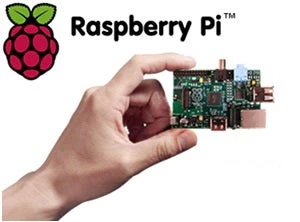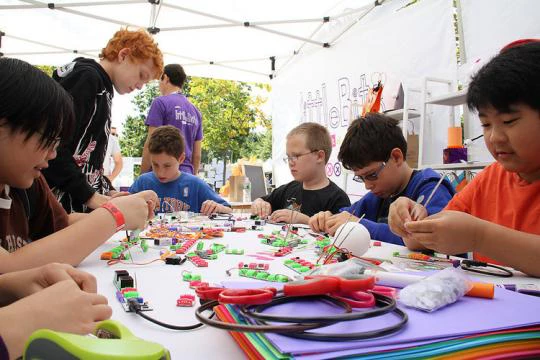Think back to when you were a child. Do you remember spending hours building and creating? Did you play with LEGO™s? Maybe you even participated in a robot building contest? How did this experience affect your curiosity and creativity skill?
LEGOs and robotics are being used as a transformative way of learning Science, Technology, Engineering, and Mathematics (STEM) mainly in primary and secondary schools. LEGOs are also being used in pre-schools to develop creativity skills for children. Research has shown that the use of educational robotics increases students’ academic achievement in specific STEM concept areas and promotes cooperative learning and problem solving skills. Some studies also underscore robotics’ potential to engage females and underserved youth in learning STEM subjects.
Similarly, new technologies in computer programming and electronics are transforming the way that students learn how to work in these fields, as well as improving their problem solving and creativity skills. Delivery mechanisms of these technologies also help children learn not only STEM subjects but also art and design (jointly called “ STEAM”, A for Art). And the fact that many of these tools are built on an open source platform allows teachers to create a community of practice and to learn from each other.
So, what are these technologies? Let’s look at two types of technologies and implementation models from the UK and the US.

Photo credit: Jesse Hirsh
1. The first technology is a low-cost microcomputer running with an easy-to-understand computer programming language called scratch, developed by the Lifelong Kindergarten Group at the Massachusetts Institute of Technology (MIT). It is open source hardware and software, providing an online user manual and libraries, downloadable software, and an online platform for teachers to share lesson plans and teaching experiences. Several microcomputers are already in the market, including Raspberry Pi ($35), Arduino ($29.95), and Beaglebone ($89).
Raspberry Pi was born in the UK to solve the issue of declining number of students studying computer science (the number dropped by 23% at undergraduate level and by 34% at graduate level) through transforming the pedagogy of computer science to make the subject more attractive for students to learn. In collaboration with the UK government and 6 education partners, Raspberry Pi, funded by Google, distributed 15,000 free microcomputers to elementary schools by incorporating the training into a curriculum. Google also sponsored ICT teacher training in conjunction with the Teach First charity.
Pros and cons of this public-private partnership model are summarized below.
Photo Credit: Mark Carson
2. The second technology is in microelectronics. LittleBits, a NYC-based startup, offers LEGO-like building blocks of electronics (base kit price is $99), an open source hardware and software, teachers’ community of practice, and workshop opportunities. Their delivery method is a bottom-up approach, emphasizing STEAM education, reflected in their active collaboration with museums in NYC. They hold workshops and participate in maker faire, a gathering of technology entrepreneurs, educators, crafters, engineers and etc to showcase what they make and learn from each other, to provide hands-on experience of teaching electronics utilizing LittleBits in NYC and other countries, including schools for orphans in Iraq and Sri Lanka. After the workshops, they hope that teachers are inspired and create their own lessons plans and share them online. Many teachers have mentioned that the online platform for lesson sharing was very useful as it provides support, feedback, and a sense of community.
Pros and Cons of this bottom-up workshop-based model are summarized below.
Pros:
-Teachers can create a community with other teachers who they do not usually interact with.
-Teachers can learn from each other and create a support community.
-Teachers can improve their pedagogy through exchanging lessons online.
Cons:
-Introduction of technologies into a classroom depends on teachers
While these models are still in a nascent stage, there seems to be an optimistic prospective to transform STEM/STEAM education in the future as the open source hardware and software allows for continuous transformation through bringing creativity and new ideas from everywhere in the world.
LEGOs and robotics are being used as a transformative way of learning Science, Technology, Engineering, and Mathematics (STEM) mainly in primary and secondary schools. LEGOs are also being used in pre-schools to develop creativity skills for children. Research has shown that the use of educational robotics increases students’ academic achievement in specific STEM concept areas and promotes cooperative learning and problem solving skills. Some studies also underscore robotics’ potential to engage females and underserved youth in learning STEM subjects.
Similarly, new technologies in computer programming and electronics are transforming the way that students learn how to work in these fields, as well as improving their problem solving and creativity skills. Delivery mechanisms of these technologies also help children learn not only STEM subjects but also art and design (jointly called “ STEAM”, A for Art). And the fact that many of these tools are built on an open source platform allows teachers to create a community of practice and to learn from each other.
So, what are these technologies? Let’s look at two types of technologies and implementation models from the UK and the US.

Photo credit: Jesse Hirsh
1. The first technology is a low-cost microcomputer running with an easy-to-understand computer programming language called scratch, developed by the Lifelong Kindergarten Group at the Massachusetts Institute of Technology (MIT). It is open source hardware and software, providing an online user manual and libraries, downloadable software, and an online platform for teachers to share lesson plans and teaching experiences. Several microcomputers are already in the market, including Raspberry Pi ($35), Arduino ($29.95), and Beaglebone ($89).
Raspberry Pi was born in the UK to solve the issue of declining number of students studying computer science (the number dropped by 23% at undergraduate level and by 34% at graduate level) through transforming the pedagogy of computer science to make the subject more attractive for students to learn. In collaboration with the UK government and 6 education partners, Raspberry Pi, funded by Google, distributed 15,000 free microcomputers to elementary schools by incorporating the training into a curriculum. Google also sponsored ICT teacher training in conjunction with the Teach First charity.
Pros and cons of this public-private partnership model are summarized below.
Pros:
-Schools can try out new methodologies in a cost effective way through a private sector partnership
-Students will have access to new technologies regardless of their socio economic status if it is incorporated in the school curriculum
Cons:
-Schools may be used as marketing venues by companies in return for teaching resources, books, sports equipment or computers
-Commercial sponsorship may undermine teacher’s efforts to educate children about the dangers of manipulation and commercial exploitation

Photo Credit: Mark Carson
2. The second technology is in microelectronics. LittleBits, a NYC-based startup, offers LEGO-like building blocks of electronics (base kit price is $99), an open source hardware and software, teachers’ community of practice, and workshop opportunities. Their delivery method is a bottom-up approach, emphasizing STEAM education, reflected in their active collaboration with museums in NYC. They hold workshops and participate in maker faire, a gathering of technology entrepreneurs, educators, crafters, engineers and etc to showcase what they make and learn from each other, to provide hands-on experience of teaching electronics utilizing LittleBits in NYC and other countries, including schools for orphans in Iraq and Sri Lanka. After the workshops, they hope that teachers are inspired and create their own lessons plans and share them online. Many teachers have mentioned that the online platform for lesson sharing was very useful as it provides support, feedback, and a sense of community.
Pros and Cons of this bottom-up workshop-based model are summarized below.
Pros:
-Teachers can create a community with other teachers who they do not usually interact with.
-Teachers can learn from each other and create a support community.
-Teachers can improve their pedagogy through exchanging lessons online.
Cons:
-Introduction of technologies into a classroom depends on teachers
While these models are still in a nascent stage, there seems to be an optimistic prospective to transform STEM/STEAM education in the future as the open source hardware and software allows for continuous transformation through bringing creativity and new ideas from everywhere in the world.


Join the Conversation